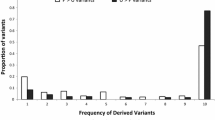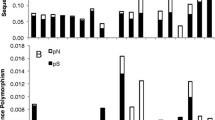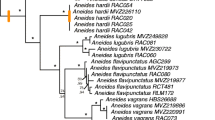Summary
Two nuclear genes fromDrosophila yakuba were cloned, the orthologue of theDrosophila melanogaster period (per) clock gene and the orthologue of an unnamedD. melanogaster gene adjacent toper, which encodes a 0.9-kb RNA transcript. The DNA and presumed protein sequences of both genes are presented and compared with their orthologues inD. melanogaster. Consistent with theper orthologues described in otherDrosophila species, some parts of theper gene have accumulated nonsynonymous substitutions at a much higher rate than others. This contrasts markedly with the evenly distributed amino acid replacements observed in the protein encoded by the adjacent gene. The level of synonymous and nonsynonymous substitutions betweenD. yakuba andD. melanogaster per were compared in small subsections across the gene. The results suggest that the divergence observed in the less well-conserved regions of theper protein is principally due to reduced selective constraint, although the limitations of the method used prevent positive selection acting upon a small proportion of sites being ruled out. The level of silent substituion observed in both of these nuclear genes is very similar to the level of silent substitution previously reported betweenD. melanogaster andD. yakuba mitochondrial genes, confirming several indirect studies, which have suggested that, in contrast to the case in mammals, silent sites are evolving at similar rates in mitochondrial and nuclear genes ofDrosophila.
Similar content being viewed by others
References
Bargiello TA, Saez L, Baylies MK, Gasis G, Young MW, Spray DC (1987) TheDrosophila clock geneper affects intercellular junctional communication. Nature 328:686–691
Baylies MK, Bargiello TA, Jackson FR, Young MW (1987) Changes in abundance and structure of theper gene product can alter periodicity of theDrosophila clock. Nature 326:390–392
Benton WD, Davis RW (1977) Screening λgt recombinant clones by hybridization to single plaques in situ. Science 196:180–183
Biggin MD, Gibson TJ, Hong GF (1983) Buffer gradient gels and35S label as an aid to rapid DNA sequence determination. Proc Natl Acad Sci USA 80:3963–3965
Blobel G (1980) Intracellular protein topogenesis. Proc Natl Acad Sci USA 77:1496–1500
Bock IR, Wheeler MR (1972) TheDrosophila melanogaster species group. Univ Texas Publ no. 7213:1–102
Brown WM, Prager EM, Wang A, Wilson AC (1982) Mitochondrial sequences of primates: tempo and mode of evolution. J Mol Evol 18:225–239
Burla H (1954) Zur Kenntnis der Drosophiliden der Elfenbeinküste (Französisch West Africa). Rev Suisse Zool 61:1–218
Caccone A, Amato GD, Powell JR (1988) Rates and patterns of scnDNA and mtDNA divergence with theDrosophila melanogaster subgroup. Genetics 118:671–683
Church GM, Gilbert W (1984) Genomic sequencing. Proc Natl Acad Sci USA 81:1991–1995
Citri Y, Colot HV, Jacquier AC, Yu Q, Hall JC, Rosbash M (1987) A family of unusually spliced biologically active transcripts encoded by aDrosophila clock gene. Nature 326:42–47
Clary DO, Wolstenholme DR (1985) The mitochondrial DNA molecule ofDrosophila yakuba: nucleotide sequence, gene organisation and genetic code. J Mol Evol 22:252–271
Colot HV, Hall JC, Rosbash M (1988) Interspecific comparison of theperiod gene ofDrosophila reveals large blocks of nonconserved coding DNA. EMBO J 7:3929–3937
Crews ST, Thomas JB, Goodman CS (1988) TheDrosophila single-minded gene encodes a nuclear protein with sequence similarity to theper gene product. Cell 52:143–151
DeSalle R, Freedman T, Prager EM, Wilson AC (1987) Tempo and mode of sequence evolution in mitochondrial DNA of HawaiianDrosophila. J Mol Evol 26:157–164
Devereux J, Haeberli P, Smithies O (1984) A comprehensive set of sequence analysis programs for the VAX. Nucleic Acids Res 12:387–396
Dover GA (1989) Slips, strings and species. Trends Genet 5: 100–102
Feinberg AP, Vogelstein B (1984) A technique for radiolabelling DNA restriction fragments to high specific activity. Anal Biochem 137:266–267
Filipski J (1987) Correlation between molecular clock ticking, codon usage, fidelity of DNA repair, chromosome banding and chromatin compactness in germline cells. FEBS Lett 217: 184–186
Hall JC, Kyriacou CP (1990) Genetics of biological rhythms inDrosophila. Adv Insect Physiol 22:221–298
Hall JC, Rosbash M (1988) Mutations and molecules influencing biological rhythms. Annu Rev Biochem 11:373–393
Hamblen M, Zehring WA, Kyriacou CP, Reddy P, Yu Q, Wheeler DA, Zweibel LJ, Konopka RJ, Rosbash M, Hall JC (1986) Germ-line transformation involving DNA from theperiod locus inDrosophila melanogaster: overlapping genomic fragments that restore circadian and ultradian rhythmicity toper o andper − mutants. J Neurogenet 3:249–291
Higgins DG, Sharp PM (1988) CLUSTAL: a package for performing multiple sequence alignments on a microcomputer. Gene 73:237–244
Jackson FR, Bargiello TA, Yun S-H, Young MW (1986) Product ofper locus ofDrosophila shares homology with proteoglycans. Nature 320:185–188
Jeffreys AJ, Barrie P, Harris S, Fawcett D, Nugent Z, Boyd C (1982) Isolation and sequence analysis of a hybrid δ-globin pseudogene from the brown lemur. J Mol Biol 156:487–503
Jowett T (1986) Preparation of nucleic acids. In: Roberts DB (ed)Drosophila. A practical approach. IRL Press, Oxford, pp 275–286
Kassis JA, Poole J, Wright DK, O'Farrell P (1986) Sequence conservation in the protein coding and intron regions of theengrailed transcription unit. EMBO J 5:3583–3589
Kimura M (1980) A simple method for estimating evolutionary rates of base substitutions through comparative studies of nucleotide sequences. J Mol Evol 16:111–120
Konopka RJ, Benzer S (1971) Clock mutants inDrosophila melanogaster. Proc Natl Acad Sci USA 68:2112–2116
Kyriacou CP, Hall JC (1980) Circadian rhythm mutations inDrosophila melanogaster affect short-term fluctuations in the male's courtship song. Proc Natl Acad Sci USA 77:6729–6733
Kyriacou CP, Hall JC (1986) Interspecific genetic control of courtship song production and reception inDrosophila. Science 232:494–497
Kyriacou CP, Oldroyd M, Wood J, Sharp M, Hill MC (1990) Clock mutations alter developmental timing inDrosophila. Heredity (in press)
Lachaise D, Cariou M-L, David JR, Lemeunier F, Tsacas L, Ashburner M (1988) Historical biogeography of theDrosophila melanogaster species subgroup. Evol Biol 22:159–225
Levinson G, Gutman GA (1987) Slipped-strand mispairing: a major mechanism for DNA sequence evolution. Mol Biol Evol 4:203–221
Li W-H, Wu C-I, Luo C-C (1985) A new method for estimating synonymous and nonsynonymous rates of nucleotide substitution considering the relative likelihood of nucleotide and codon changes. Mol Biol Evol 2:150–174
Li W-H, Tanimura M, Sharp PM (1987) An evaluation of the molecular clock hypothesis using mammalian DNA sequences. J Mol Evol 25:330–342
Löenen W, Brammar WJ (1980) A bacteriophage lambda vector for cloning large DNA fragments made with several restriction enzymes. Gene 20:249–259
Lorenz LJ, Hall JC, Rosbash M (1989) Expression of aDrosophila mRNA is under circadian clock control during putation. Development (in press)
Maniatis T, Fritsch EF, Sambrook J (1982) Molecular cloning. A laboratory manual. Cold Spring Harbor Laboratory, Cold Spring Harbor NY
Martin CH, Meyerowitz E (1986) Characterisation of the boundaries between adjacent rapidly and slowly evolving genomic regions inDrosophila. Proc Natl Acad Sci USA 83: 8654–8658
Messing J (1983) New M13 vectors for cloning. Methods Enzymol 101:20–89
Mount SM (1982) A catalogue of splice junctions. Nucleic Acids Res 10:459–472
Norrander J, Kempe T, Messing J (1983) Construction of improved M13 vectors using oligodeoxynucleotide-directed mutagenesis. Gene 26:101–106
Ochman H, Wilson AC (1987) Evolution in bacteria: evidence for a universal rate in cellular genomes. J Mol Evol 26:74–86
Padgett RA, Grabowski PJ, Konarska MM, Seiler S, Sharp PA (1986) Splicing of messenger RNA precursors. Annu Rev Biochem 55:1119–1150
Petersen G, Hall JC, Rosbash M (1988) ThePeriod gene ofDrosophila carries species-specific behavioral instructions. EMBO J 7:3929–3947
Powell JR, Caccone A, Armato GD, Yoon C (1986) Rates of nucleotide substitution inDrosophila mitochondrial DNA and nuclear DNA are similar. Proc Natl Acad Sci USA 83:9090–9093
Proudfoot NJ, Brownlee GG (1976) 3′ non-coding region sequences in eukaryotic messenger-RNA. Nature 263:211–214
Reddy P, Zehring WA, Wheeler DA, Pirrotta V, Hadfield C, Hall JC, Rosbash M (1984) Molecular analysis of theperiod locus inDrosophila melanogaster and identification of a transcript involved in biological rhythms. Cell 38:701–710
Reddy P, Jacquier AC, Abovich N, Petersen G, Rosbash M (1986) Theperiod clock locus ofD. melanogaster codes for a proteoglycan. Cell 46:53–61
Sanger F, Nicklen S, Coulson AR (1977) DNA sequencing with chain-terminating inhibitors. Proc Natl Acad Sci USA 74: 5463–5467
Schwartz TL, Tempel BL, Papazian DM, Jan YN, Jan LY (1988) Multiple potassium-channel components are produced by alternative splicing at theShaker locus inDrosophila. Science 331:137–142
Sharp PM, Li W-H (1989) On the rate of DNA sequence evolution inDrosophila. J Mol Evol 28:398–402
Solignac M, Monnerot M, Mounolou J-C (1986) Mitochondrial DNA evolution in theMelanogaster species subgroup ofDrosophila. J Mol Evol 23:31–40
Staden R (1980) A new computer method for the storage and manipulation of DNA reading data. Nucleic Acids Res *: 3673–3694
Stewart C-B, Schilling JW, Wilson AC (1987) Adaptive evolution in the stomach enzymes of foregut fermenters. Nature 330:401–404
Tanaka T, Nei M (1989) Positive Darwinian selection observed at the variable region genes of immunoglobulins. Mol Biol Evol 6:447–459
Tautz D, Trick M, Dover GA (1986) Cryptic simplicity in DNA is a major source of genetic variation. Nature 322:652–656
Thackeray JR (1989) Molecular analysis of behavioural rhythms inDrosophila. PhD Thesis, University of Leicester
Thomas JB, Crews ST, Goodman CS (1988) Molecular genetics of thesingle-minded locus: a gene involved in the development of theDrosophila nervous system. Cell 52:133–141
Topal MD, Fresco JR (1976) Complementary base pairing and the origin of substitution mutations. Nature 263:285–289
Treier M, Pfeifle C, Tautz D (1989) Comparison of the gap segmentation genehunchback betweenDrosophila melanogaster andDrosophila virilis reveals novel modes of evolutionary change. EMBO J 8:1517–1525
Wilson AC, Cann RL, Carr SM, George M, Gyllensten UB, Helm-Bychowski KM, Higuchi RG, Palumbi SR, Prager EM Sage RD, Stoneking M (1985) Mitochondrial DNA and two perspectives on evolutionary genetics. Biol J Linn Soc 26:375–400
Yu Q, Jacquier AC, Citri Y, Hamblen M, Hall JC, Rosbash M (1987a) Molecular mapping of point mutations that stop or speed up biological clocks inDrosophila melanogaster. Proc Natl Acad Sci USA 84:784–788
Yu Q, Colot HV, Kyriacou CP, Hall JC, Rosbash M (1987b) Behaviour modification by in vitro mutagenesis of a variable region within theperiod gene ofDrosophila. Nature 326:765–769
Zehring WA, Wheeler DA, Reddy P, Konopka RJ, Kyriacou CP, Rosbash M, Hall JC (1984) P-element transformation withperiod locus DNA restores rhythmicity to mutant, arrhythmicDrosophila melanogaster. Cell 39:369–376
Author information
Authors and Affiliations
Rights and permissions
About this article
Cite this article
Thackeray, J.R., Kyriacou, C.P. Molecular evolution in theDrosophila yakuba period locus. J Mol Evol 31, 389–401 (1990). https://doi.org/10.1007/BF02106054
Received:
Revised:
Issue Date:
DOI: https://doi.org/10.1007/BF02106054




